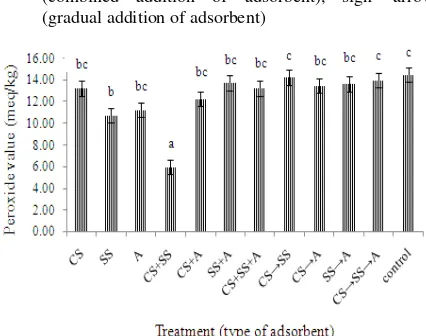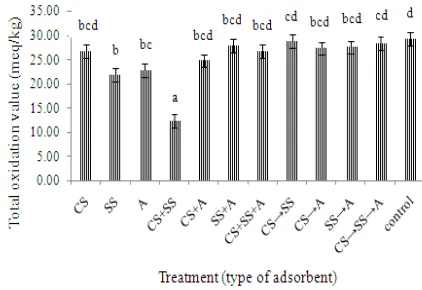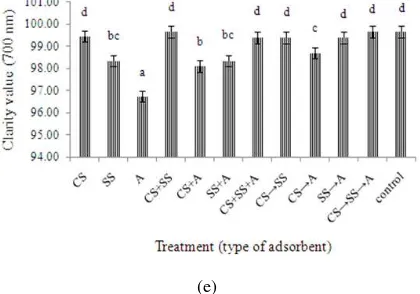Advance Journal of Food Science and Technology 6(5): 616-621, 2014 ISSN: 2042-4868; e-ISSN: 2042-4876
© Maxwell Scientific Organization, 2014
Submitted: January 16, 2014 Accepted: January 25, 2014 Published: May 10, 2014
Corresponding Author: Sugeng Heri Suseno, Department of Aquatic Product Technology, Faculty of Fisheries and Marine Sciences, Bogor Agricultural University, Jl. Agatis Darmaga 16680 Bogor, Indonesia
Purification of Sardine Oil Using Adsorbent (Active Filter) of Scallop Shells,
Carp Scales and Attapulgite
Sugeng Heri Suseno, Yosephina M.J. Batafor, Nurjanah and Ayu Fitri Izaki
Department of Aquatic Product Technology, Faculty of Fisheries and Marine Sciences, Bogor Agricultural University, Jl. Agatis Darmaga 16680 Bogor, Indonesia
Abstract: Fish oil especially from sardine has contain great omega 3, but it needs purification because has poor quality. Fish oil purification can be done by using various types of adsorbents. One of them are scallop shells and carp scales. The purpose of this study is to choose the best type of active filter (adsorbent) to improve the quality of fish oil. Sardine oil is purified using an active filter (adsorbent) of carp scales, scallop shells and attapulgite. The result this study show that the best treatment of adsorbent types is carp scales+scallop shell adsorbent.
Keywords: Active filter, adsorbent, refining, sardine oil, secondary primary oxidation
INTRODUCTION
Sardine (Sardinella lemuru) has great potential as a source of fish oil (5-20 %) and omega 3. Fish oil is useful for health because it contains a lot of unsaturated fatty acids with many double bonds (PUFA) omega 3 that is Eicosapentaenoic acid (EPA) and Docosa Hexaenoic Acid (DHA) are beneficial to the body (Aidos, 2002). Omega 3 fatty acids are most abundant in fish oil are EPA, AA and DHA. These fatty acids can cure various diseases such as atherosclerosis (narrowing and hardening of the arteries), thrombosis mellitus and other joint or bone disease, asthma and prevent the aging process (Duthie and Barlow, 1992).
Fishmeal and canning process of sardine produces by-product fish oils containing large enough omega 3 fatty acids in high levels and can be used as a source of omega 3 fatty acids. Fish oil purification efforts with an effective and efficient method are very important to improve the quality of fish oils so suitable for consumption. One is the method of active filtration. Active filtration serves to fix the color of the oil, reducing unwanted odor components, sulfur compounds, heavy metals and can reduce the production of fat oxidation are peroxides, aldehydes and ketones (Estiasih, 2009). Fish oil purification can be carried out by making use of various kinds of adsorbents. Scallop shells and carp scales are one of the by-product of the fishery that has not been properly utilized and wasted into waste. Esmaeli et al. (2012) and Checa et al. (2007) showed that the results of Scanning Electron Microscope (SEM) on the structure of carp scales and shells of the bivalve have extensive porous surface that can be used to physically adsorb an adsorbate through direct contact surface. Additionally
scallop shells and carp scales containing chitin that serve as metal ion chelating. Treatment of active filtration is done by using a material that has the ability to adsorption impurity components. The purpose of this study is to choose the best type of active filter (adsorbent) to improve the quality of fish oil.
MATERIALS AND METHODS
The main materials used in this study are crude sardine oil from Bali industry. The adsorbent used was carp scales (Cyprinus carpio) obtained from Bogor market, scallop shells (Amusium pleuronectes) came from Banten and attapulgite obtained from the Laboratory of Pharmacy, University of Pancasila. Carp scales and scallop shells sun dried and destroyed so that the form of flour, while attapulgite has been shaped flour. Other supporting materials are the materials used for the analysis of the quality of fish oil in the form of distilled water, glacial acetic acid, chloroform, a solution of potassium iodine (KI) saturated solution of sodium thiosulfate (Na2S2O3) 0.1 N, 0.1 N KOH
solution, the indicator of phenolphthalein, 96 ethanol, 1% starch, isooktan, reagent p-anisidine, n-hexane. The equipments used for the purification of fish oil include erlenmeyer glass, aluminum foil, magnetic stirrer, digital scales, pipette and high speed refrigerated centrifuge himac brand HITACHI CR 21G. Other support equipment such as buret, stative, 2500 UV-Vis spectrophotometer LaboMed brands, bulbs, test tubes and pumpkin drinks.
Adv. J. Food Sci. Technol., 6(5): 616-621, 2014
control (C), carp scales (CS), scallop shells (SS), attapulgite (A), carp scales + scallop shells (CS + SS), carp scales + attapulgite (CS + A), scallop shell + attapulgite (CS + A), carp scales + scallop shells + attapulgite (CS + SS + A), gradually treatment carp scales and scallop shells (CS-SS), gradually treatment carp scales and attapulgite (CS-A), gradually treatment scallop shells and attapulgite (SS-A), gradually treatment carp scales, scallop shells and attapulgite (CS-SS-A), 3% adsorbent concentration, agitation time fish oil and adsorbent using magnetic stirrer for 20 min at room temperature (±29°C), after which a mixture of fish oil and adsorbent, then separated by centrifuging at a speed of 10000 rpm for 30 min at a temperature of 10°C.
Analysis of fish oil quality: Oil purifying results using the active filter (adsorbent) then analyzed free fatty acid value (AOCS, 1998, method No. Ca 5a-40), peroxide value (AOAC, 2000, method No. 965.33b), p-anisidine value (IUPAC, 1987, method No. 2.504), total oxidation value (AOCS, 1997) and clarity (wavelength 450, 550, 620, 665, 700 nm, respectively) (AOAC, 1995).
Data analysis: Result of purifying process was statistically processed using ANOVA by SPSS software version 16.0 to see the regression parameter coefficients, percent significance (confidence interval) and the pattern of interaction of factors that significantly influence the response.
RESULTS AND DISCUSSION
Free fatty acid (FFA): Analysis of free fatty acids is an analysis conducted to determine the amount of free fatty acids formed by the breakdown of oil through the chemical process of hydrolysis and biologically by microbes. The results of the analysis of free fatty acids of sardine oils with types of adsorbent treatment are presented in Fig. 1.
The results of the analysis of the value of free fatty acids sardine oil showed the highest value generated by gradually treatment of scallop shell and attapulgite adsorbent (12.48±0.63%) and the lowest value in the treatment of carp scales+shell scallop adsorbent (6.70±0.07%). Statistical analysis showed that the type of adsorbent treatment affected (p<0.05) to the value of free fatty acids (Fig. 1). Bimbo (1998) suggest specification quality crude fish oil with a free fatty acid content ranged from 1 to 7%, but typically ranges from 2 to 5%, while Young (1986) states that the maximum acceptable value of 4.0%. The presence of free fatty acids in oil due to oil undergoes hydrolysis process. Hydrolysis of triglycerides in the oil will produce fatty acids and monoglycerides components (Winarno, 2004). The difference decreased levels of free fatty acid
Fig. 1: Free fatty acid value of sardine oil; Note: CS (carp scales Cyprinus carpio), SS (scallop shells Amusium pleuronectes) and A (attapulgite). sign 'plus' (combined addition of adsorbent), sign 'arrow' (gradual addition of adsorbent)
Fig. 2: Peroxide value of sardine oil; Note: CS (carp scales Cyprinus carpio), SS (scallop shells Amusium pleuronectes) and A (attapulgite). sign (gradual addition of adsorbent)
levels may occur by the differences in the type of adsorbent used. Different types of adsorbents will have a polarity, the active surface, surface area, porosity, particle size, pH and different of water content (Zhu et al., 1994).
Peroxide Value (PV): Peroxide value is the most important value to determine the degree of damage to the oil or fat. The results of the analysis of the peroxide value of sardine oil with treatment of adsorbent types are presented in Fig. 2.
Adv. J. Food Sci. Technol., 6(5): 616-621, 2014
adsorbent treatment not meets the standards of the International Fish Oil Standard (IFOS (International Fish Oils Standard), 2011) (≤3.75 meq/kg). Standard peroxide value according to the Council for Responsible Nutrition (CRN (Council for Responsible Nutrition), 2006) is 5 meq/kg. Increased peroxide is because each stage of the process requires the characterization of the oil temperature and long storage time. Boran et al. (2006) reported the storage conditions of fish oil and fatty acid profiles contained in fish oil affect oxidative damage. The quality of the fish used for oil extraction, oil extraction process and storage conditions will affect peroxide value of crude fish oil (EFSA (European Food Safety Authority), 2010). Winarno (2004) oil containing unsaturated fatty acids are high susceptible to oxidation. Indicating a high peroxide value of fat or oil has been oxidized, but at a lower value is not always indicate that the oxidation state is still early.
P-anisidine value (P-AV): P-anisidine value analysis is an analysis that is performed to measure secondary oxidation products (carbon component) (AOCS, 1994). The results of the analysis of the p-anisidine value of sardine oil with adsorbent types of treatment are presented in Fig. 3.
The results of the analysis of the p-anisidine value of sardine oil showed the highest value generated by treatment of carp scales+scallop shells adsorbent (0.26±0.05 meq/kg) and the lowest value in the treatment of scallop shells adsorbent (0.22±0.15 meq/kg). Statistical analysis showed that the type of adsorbent treatment did not affect (p>0.05) on p-anisidine value (Fig. 3). P-p-anisidine value with treatment type adsorbents can meet the standards of the International Fish Oil Standard (IFOS (International Fish Oils Standard), 2011) (≤15 meq/kg). P-anisidine value is performed to measure the carbon components that influence the formation of unpleasant odors (off-flavor) results from the oxidation process (EFSA (European Food Safety Authority), 2010).
Total oxidation value (Totox): Analysis of total oxidation is an analysis conducted to determine the presence of different compounds such as hydroperoxides, aldehydes, ketones, mainly produced by the degradation of PUFA in pro-oxidant conditions, especially high temperature, oxygen and light metal compounds. The results of the analysis of the total oxidation of sardine oil with adsorbent types of treatment are presented in Fig. 4.
The results of the analysis of the total oxidation value of sardine oil showed the highest value generated by treatment of carp scales and scallop shells adsorbent (28.75±2.46 meq/kg) and the lowest value in the treatment of carp scales+scallop shells adsorbent (12.26±1.05 meq/kg). Statistical analysis showed that
Fig. 3: P-anisidine value of sardine oil; Note: CS (carp scales Cyprinus carpio), SS (scallop shells Amusium pleuronectes) and A (attapulgite). sign 'plus' (combined addition of adsorbent), sign 'arrow' (gradual addition of adsorbent)
Fig. 4: Total oxidation value of sardine oil; Note: CS (carp scales Cyprinus carpio), SS (scallop shells Amusium pleuronectes) and A (attapulgite). sign (gradual addition of adsorbent)
Adv. J. Food Sci. Technol., 6(5): 616-621, 2014
(a)
(b)
(c)
(d)
(e)
Fig. 5: Percent clarity of fish oil transmission after the addition adsorbent with a wavelength of 450 (a), 550 (b), 620 (c), 665 (d) and 700 nm (e)
and temperature. The main constituent of the shells of shrimp or shellfish is chitin, a natural polysaccharide which has many uses such as a chelating agent, emulsifier and adsorbent (Bhuvana, 2006).
Clarity value: Measurement of fish oil clarity performed at 5 wavelengths, i.e., 450, 550, 620, 665 and 700 nm. Fish oil purity level is indicated by the value of percent transmission read on a spectrophotometer. Percent value of high transmission and approaching 100% indicates that fish oil was observed to have a good level of clarity. The results of the analysis of percent light transmission to the sardine oil with the treatment type of adsorbent at 5 wavelengths are presented in Fig. 5.
The results of the analysis of fish oil percent light transmission at a wavelength of 450 nm showed the highest value generated by treatment of carp scales adsorbent (60.30±16.50%) and the lowest value in the treatment of attapulgite adsorbent (41.50±0.30%). Statistical analysis showed that the type of adsorbent treatment affected (p<0.05) to the value of clarity (Fig. 5a). Figure 5a shows at a wavelength of 450 nm, carp scales are the most effective adsorbent to purify fish oil seen from the greatest percent transmission.
The results of the analysis of fish oil percent light transmission at a wavelength of 550 nm showed the highest value generated by gradually treatment of carp scales, scallop shell and attapulgite (89.55±2.05%) and the lowest value in the treatment of carp scales adsorbent (78.35±5:05%). Statistical analysis showed that the type of adsorbent treatment affect (p<0.05) to the value of clarity (Fig. 5b). Figure 5b shows at a wavelength of 550 nm, carp scales scallop and shell-attapulgite is the most effective adsorbent to purify fish oil seen from the greatest percent transmission.
Adv. J. Food Sci. Technol., 6(5): 616-621, 2014
scallop shell and attapulgite adsorbent (98.00±1.30%)
and the lowest value in the treatment of attapulgite adsorbent (91.35±0.75%). Statistical analysis showed that the type of adsorbent treatment affect (p<0.05) to the value of clarity (Fig. 5c). Figure 5c shows at a wavelength of 620 nm, attapulgitescallop shell is the most effective adsorbent to purify fish oil seen from the greatest percent transmission.
The results of the analysis of fish oil percent light transmission at a wavelength of 665 nm showed the highest value generated by treatment of carp scales+ scallop shells adsorbent (98.45±1.15%) and the lowest value in the treatment of attapulgite adsorbent (93.45±0.75%). Statistical analysis showed that the type of adsorbent treatment affected (p<0.05) to the value of clarity (Fig. 5d). Figure 5d shows at a wavelength of 665 nm, carp scales+scallop shell is the most effective adsorbent to purify fish oil seen from the greatest percent transmission.
The results of the analysis of fish oil percent light transmission at a wavelength of 700 nm showed the highest value generated by the treatment of adsorbent carp scales+scallop shells (99.65±0:15%) and the lowest value in the treatment of attapulgite adsorbent (96.75±0.65%). Statistical analysis showed that the type of adsorbent treatment affected (p<0.05) to the value of clarity (Fig. 5d). Figure 5d shows at a wavelength of 700 nm, carp scales+scallop shell is the most effective adsorbent to purify fish oil seen from the greatest percent transmission.
CONCLUSION
Fish oil purification can be done by using adsorbent such as carp scales, scallop shells and attapulgite. Carp scales+scallop shell is the best adsorbent treatment characteristics, seen from the total oxidation that can meet the standards of IFOS (International Fish Oils Standard) (2011). The best value with clarity percent light transmission values approaching 100 scales contained in the adsorbent treatment carp scales+scallop shells at a wavelength of 665 nm and 700 nm.
ACKNOWLEDGMENT
This study completion would not have been possible without the assistance of many people who gave their support. To them I would like to convey my heartfelt gratitude and sincere appreciation.
REFERENCES
Aidos, I., 2002. Production of high-quality fish oil from Herring by-products. Ph.D. Thesis, Wageningen University, Netherlands.
AOAC, 1995. Official Methods of Analysis of the Association of Official Analytical Chemist. AOAC Inc., Washington, US.
AOAC, 2000. Official Methods of Analysis of the Association of Agricultural Chemists. 17th Edn., AOAC Inc., Washington, US.
AOCS, 1997. Official Methods and Recommended Practices of the American Oil Chemists' Society. Official Method cd 8-53 Peroxide Value, cd18-90 p-ansidine Value, cg 3-91 Recommended Practices for Assessing Oil Quality and Stability. AOCS Press, Urbana, US.
AOCS, 1998. Official Methods and Recommended Practices of the American Oil Chemists Society. 5th Edn., AOCS Press, Champaign, US.
AOCS, 1994. Official Method Cd 18-90: p-anisidine value. Am. Oil Chem. Soc. Champaign, IL, US. Bhuvana, 2006. Studies on frictional behaviour of
chitosan-coated fabrics, aux. Res. J., 6(4): 123-130. Bimbo, A.P., 1998. Guidelines for characterizing food-grade fish oils. Inform. Int. News Fats Oils Relat. Mater., 9(5): 473-483.
Boran, G., H. Karacam and M. Boran, 2006. Change in the quality of fish oils due to storage and time. J. Food Chem., 98(6): 693-698.
Checa, G.A., J.E.D Francisco and B.R. Alejandro, 2007. Crystallographic structure of the foliate d calcite of bivalves. J. Struct. Biol., 157: 393-402.
CRN (Council for Responsible Nutrition), 2006. Voluntary Monograph. Retrieved form: http:// www.crausa.org/pdfs/O3FINALMONOGRAPHdo c.pdf. (Accessed on: March 12th, 2011)
Duthie, I.F. and S.M. Barlow, 1992. Dietary lipid exemplified by fish oils and their n-3 fatty acid. Food Sci. Technol., 6: 20-35.
Esmaeli, H.R., A. Gholamifard, N. Zarei and A. Arshadi, 2012. Scale structure of a cyprinid fish, Garra Rossica (Nikol’skii, 1900) using scanning electron microscope (SEM). Iran. J. Sci. Technol., A4: 487-492.
Estiasih, T., 2009. Fish Oil: Technology and Implementation for Food and Health. Graha Ilmu, Yogyakarta (ID).
EFSA (European Food Safety Authority), 2010. Scientific opinion on fish oil for human consumption. Food hygiene, including rancidity. EFSA J., 8(10): 1874.
IFOS (International Fish Oils Standard), 2011. Fish Oil Purity Standards. Retrieved from:
http://www.omegavia.com/best-fish-oil-supplement-3. (Accessed on: September 10th, 2013)
IUPAC, 1987. Standard Methods for the Analysis of Oils Arld Fats and Derivative. In: Paquot, C. and A. dan Hautfenne (Eds.), 7th Edn., Blackwell Scientific, Oxford, (GB).
Adv. J. Food Sci. Technol., 6(5): 616-621, 2014
Winarno, F.G., 2004. Chemistry of Food and Nutrition. PT Gramedia Pustaka Utama, Jakarta, ID.
Young, F.V.K., 1986. The Refining and Hydrogenation of Fish Oil. International Association of Fish Meal Manufacturers Fish Oil Bull. No. 17, St. Alban’s, Hertford, UK.


